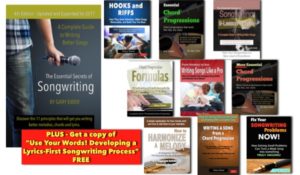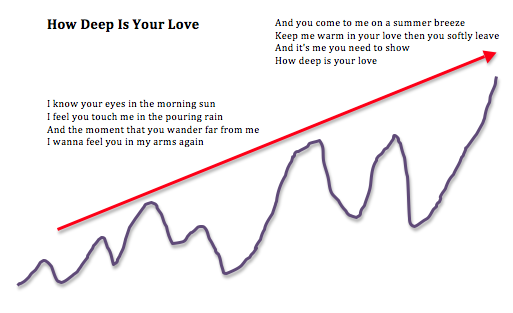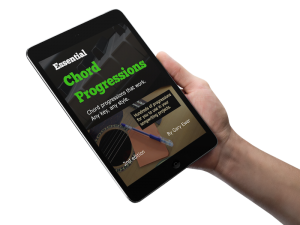Musical momentum, in practical terms, determines how likely a listener is to keep on listening to your song. Momentum propels music forward. When you hear a verse, and it sounds like it is begging for the chorus, that’s musical momentum at work.
You might also use the word energy, but the result is the same. Every song needs momentum (or energy) to keep the audience wanting to hear it from start to finish. Another term you hear that describes this quality is forward motion.
 “The Essential Secrets of Songwriting” eBook bundle comes with a free copy of “Use Your Words! Developing a Lyrics-First Songwriting Process.” Learn how to make the writing of a good lyric the starting point for your own songwriting method.
“The Essential Secrets of Songwriting” eBook bundle comes with a free copy of “Use Your Words! Developing a Lyrics-First Songwriting Process.” Learn how to make the writing of a good lyric the starting point for your own songwriting method.
I like the word momentum, if only because energy might give the impression that the song needs to be powered up, loud and fast in order to be successful. But musical energy doesn’t mean that at all. It’s a relative term. Quiet, introspective songs need musical momentum to keep people listening.
But what specifically gives music this important quality of forward motion? In other words, what is it about music that makes listeners want to keep listening? Here are some thoughts and ideas:
LYRICS
For quiet, introspective music, it’s often the lyric that steps forward. If the musical part of a song is sedate, changing little over time, the lyrics need to be meaningful, making good use of clever imagery.
Lyrics create momentum by making us want to hear what each line eventually means — what each line eventually leads to. Story songs do this with ease, but a good lyric, whether it’s describing a story or not, has a way of pulling us along, making us want to hear the next line, as in this lovely lyric for “Easy” by Justin Vernon:
When the time comes and your love is lost
I will grant you sympathy if you let me down easy
When time comes and the wind has blown over
and the north blows home? if you let me down easy
Words like “when”, “if”, and phrases like “I will” make us want to hear the rest. The sense of energy or momentum comes from the listener always wanting to hear the answering line.
MELODIES
A melody that slowly creeps upward has a way of creating a powerful kind of musical expectation, as with the verse melody in this classic hit by The Bee Gees:

As it moves upward, it sets up the eventual arrival of the chorus melody. Not every phrase moves up… some of them reverse direction and move downward. But the overall direction is upward, and takes advantage of the desire we all subconsciously have to hear where it eventually ends up.
CHORDS
Chord progressions in pop songs tend to be short and repetitive, usually 3 or 4 chords in length. For these short progressions, we get lured by its repetitive nature, wanting to hear the cycling around from end back to beginning again:
Dbmaj7 Cm7 F7
(Chorus of “Happy” – Pharrell Williams)
That’s the way most progressions work. And as one chord leads to another, we hear a building of musical tension, and then release as it finds its ending.
There are lots of other ways that musical momentum is created within a song, including:
- how instruments are subtracted and added back into the mix;
- how the music moves away from, and then eventually back to, the original key;
- the general dynamic (loudness) of the music.
For every song you write, something needs to be pulling listeners in, and enticing them to keep listening. If you find yourself feeling bored with what you’ve written, here’s what you need to do:
- Listen to a recorded version of your song several times, changing focus to concentrating on a different component each time.
- Sing your song unaccompanied (a cappella) to focus on the strength of the melody.
- Read your lyric aloud, and try to assess each line for its ability to keep listeners focused.
It may take many listens, but by changing your focus from one element to another, you should eventually find reasons for a song that sounds boring.
 Written by Gary Ewer. Follow Gary on Twitter.
Written by Gary Ewer. Follow Gary on Twitter.
 Looking for lists of progressions you can use in your own songs? “The Essential Secrets of Songwriting” eBook Bundle has 2 main collections, plus eBooks on how to harmonize your own melodies, and more.
Looking for lists of progressions you can use in your own songs? “The Essential Secrets of Songwriting” eBook Bundle has 2 main collections, plus eBooks on how to harmonize your own melodies, and more.










